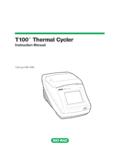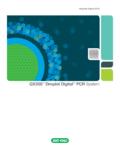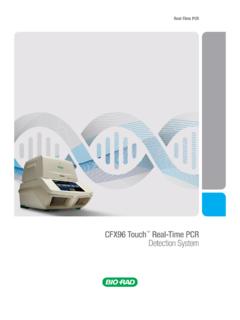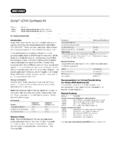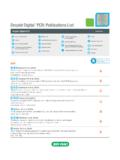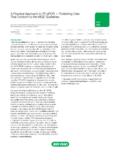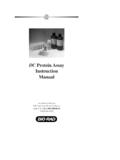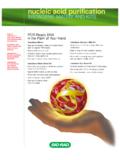Transcription of Mini Trans-Blot Electrophoretic Transfer Cell - Bio …
1 mini Trans-Blot Electrophoretic Transfer CellInstruction ManualCatalog numbers170-3930170-3935170-3989170-3836 mini - Trans-Blot Electrophoretic Transfer Cell i Assembly and DisassemblyTo insure best performance from the mini Trans-Blot Electrophoretic Transfer cell, become fully acquainted with these operating instructions before using the cell to Transfer samples. Bio-Rad recommends that you first read these instructions carefully. Then assemble and disassemble the cell completely. After these preliminary steps, you should be ready to Transfer a Cell Before UseBio-Rad also recommends that all mini Trans-Blot Electrophoretic Transfer cell components and accessories be cleaned with a suitable laboratory cleaner (such as Bio-Rad Cleaning Concentrate, catalog #161-0722) and rinsed thoroughly with distilled water before Laboratories warrants the mini Trans-Blot Electrophoretic Transfer cell against defects in materials and workmanship for 1 year.
2 If any defects occur in the instrument during this warranty period, Bio-Rad Laboratories will repair or replace the defective parts following defects, however, are specifically excluded:1. Defects caused by improper Repair or modification done by anyone other than Bio-Rad Laboratories or an authorized Use of fittings or other spare parts supplied by anyone other than Bio-Rad Damage caused by accident or Damage caused by Corrosion due to use of improper solvent or any inquiry or request for repair service, contact Bio-Rad Laboratories after confirming the model and serial number of your instrument. Table of ContentsAssembly and Disassembly .. iWash Cell Before Use.
3 IWarranty .. iSection 1 Introduction .. 1 Specifications .. 3 Safety Instructions .. 4 Section 2 mini Trans-Blot Cell Assembly and Preparation for Transfer .. 5 mini Trans-Blot Cell Description and Assembly of Parts .. 5 Preparation for Blotting .. 6 Acidic Transfers .. 9 Section 3 Transfer Conditions ..10 General Guide to Transfer Buffers and Running Notes on Electrophoretic Transfer Conditions ..11 Buffer Formulation ..13 Section 4 Strategies for Optimizing Electrophoretic Transfer .. 15 Optimizing Protein Transfer ..15 Optimizing DNA and RNA 18 Section 5 Choice of Blotting 19 Protein Blotting .. 19 DNA and RNA Blotting Membranes.
4 20 Section 6 Troubleshooting Guide .. 22 Electrophoretic Transfer .. 22 Section 7 References .. 27 Section 8 Product Information .. 29 mini - Trans-Blot Electrophoretic Transfer Cell 1 Section 1 IntroductionBlotting was first performed by Southern in 1975 with the Transfer of DNA from agarose gels to nitrocellulose Since that time, blotting has been applied to RNA2-4 and proteins5, 6 in both agarose and polyacrylamide gels. To circumvent the inefficiencies observed in various capillary transfers, electric current has been adopted for eluting proteins from polyacrylamide gels, as first described by Towbin et al. in The use of Electrophoretic Transfer has also been applied to DNA and RNA 14 Numerous publications have dealt with the topic of protein Electrophoretic Transfer 26 There have also been reviews summarizing the expanding literature being generated on Electrophoretic blotting 29 The mini Trans-Blot tank is part of Bio-Rad s modular mini -PROTEAN Tetra system.
5 The unique feature of this electrophoresis system is that the electrode modules are interchangeable. After finishing gel electrophoresis, remove the electrode module from the buffer tank, insert a new electrode module, add new buffer, and the next electrophoresis application can be mini Trans-Blot module accommodates two cassettes for Electrophoretic Transfer . The mini Trans-Blot module is useful for blotting either protein or nucleic acid from both agarose and acrylamide gels. It is also capable of blotting isoelectric focusing gels from horizontal electrophoresis cells , or DNA and RNA gels from the mini -Sub submarine electrophoresis cell. For applications where the gel is larger than x 10 cm, or when there are more than two mini gels to be transferred, the larger standard Trans-Blot cell (catalog #170-3910 or 170-3946), Criterion Blotter (catalog #170-4070, 170-4071) or the Trans-Blot SD semi-dry cell (catalog #170-3940) should be used.
6 The heart of the mini Trans-Blot cell is its electrode module. This module has the capacity to hold two gel cassettes between parallel electrodes only 4 cm apart. The driving force for blotting applications is the voltage applied over the distance between the mini - Trans-Blot Electrophoretic Transfer CellThis short 4 cm electrode distance allows generation of higher driving forces to produce efficient protein transfers. A second feature of the electrode module is that it is offset to accommodate a blue cooling unit. The cooling unit, which is completely contained within the mini Trans-Blot cell, absorbs the Joule heat generated during rapid Electrophoretic transfers.
7 The advantages of having an internal cooling unit include elimination of an expensive external cooling bath and avoidance of cumbersome cooling tubing. Other features of the mini Trans-Blot cell include gel holder cassette latches for easy handling, color coordinated cassettes and electrodes to insure proper orientation of the gel during Transfer , and an efficient design which simplifies insertion and removal of the cassettes from the electrode assembly. These features result in an Electrophoretic Transfer system which is easy to use and produces excellent blotting Electrophoretic Transfer Cell 3 SpecificationsConstructionElectrode moduleMolded polysulfoneGel holder cassettesMolded polycarbonateElectrodesPlatinum wire mm diameterBuffer chamber and lidMolded polycarbonateCooling unitPolyethyleneOverall dimensionsMini Trans-Blot cell16 (L) x 12 (W) x 18 (H) cmGel holder dimensions10 x 11 cmMaximum gel x 10 cmBuffer capacityWith cooling unit950 mlWithout cooling unit1,150 mlCleaningUse mild soap and warm water to clean the electrodes, cassettes, and buffer tank.
8 Use special care when cleaning the electrode cards. Avoid stretching or breaking the platinum wires. Do not use abrasives or strong detergents. Rinse the fiber pads under hot water and then in distilled, deionized compatibilityThe mini Trans-Blot cell components are not compatible with chlorinated hydrocarbons ( , chloroform), aromatic hydrocarbons ( , toluene, benzene), or acetone. Use of organic solvents voids all mini - Trans-Blot Electrophoretic Transfer Safety InstructionsPower to the mini Trans-Blot cell is supplied by an external DC voltage power supply. This power supply must be ground isolated in such a way that the DC voltage output floats with respect to ground.
9 All of Bio-Rad s power supplies meet this important safety requirement. Regardless of which power supply is used, the maximum specified operating parameters for the cell are: 400 VDC Maximum voltage limit 500 W Maximum power limit 40 C Maximum ambient temperature limitCurrent to the cell, provided from the external power supply, enters the unit through the lid assembly, providing a safety interlock to the user. Current to the cell is broken when the lid is removed. Do not attempt to circumvent this safety interlock, and always turn the power supply off before removing the lid, or when working with the cell in any : This Bio-Rad instrument is designed and certified to meet IEC61010-1 and EN61010-1* safety standards.
10 Certified products are safe to use when operated in accordance with the instruction manual. This instrument should not be modified or altered in any way. Alteration of this instrument will: Void the manufacturer s warranty Void the IEC61010-1 and EN61010-1 safety certification Create a potential safety hazardBio-Rad is not responsible for any injury or damage caused by the use of this instrument for purposes other than for which it is intended or by modifications of the instrument not performed by Bio-Rad or an authorized agent.* IEC61010-1 and EN61010-1 are internationally accepted electrical safety standard for laboratory instruments.!! mini - Trans-Blot Electrophoretic Transfer Cell 5 Section 2 mini Trans-Blot Cell Assembly and Preparation for mini Trans-Blot Cell Description and Assembly of Parts Filter paperLidFiber padMembraneGelFilter paperFiber padElectrode moduleBlue cooling (keep frozen at 20 C)Buffer tankGel holder cassette6 mini - Trans-Blot Electrophoretic Transfer Preparation for BlottingStore the blue cooling unit in your laboratory freezer at 20 C until ready to use.
